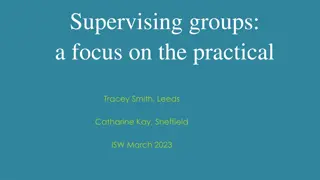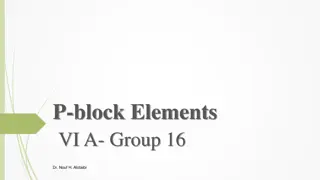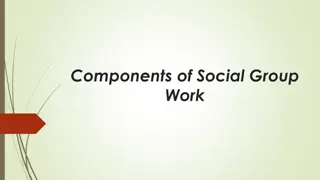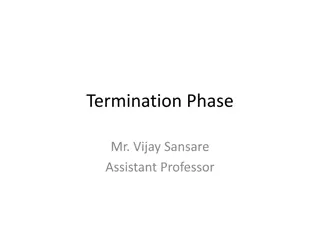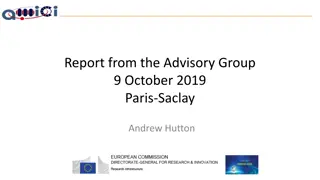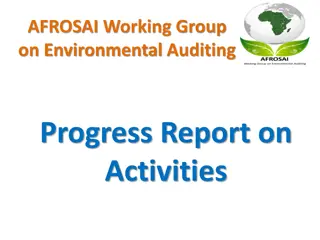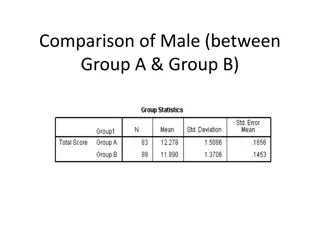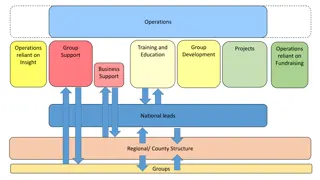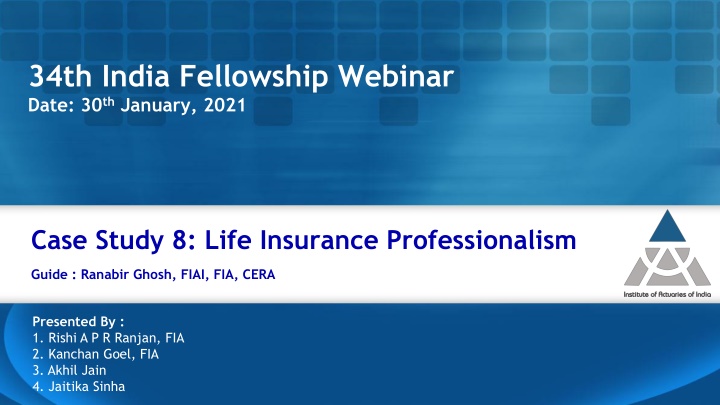
Life Insurance Professionalism Guide: Insights and Recommendations
Gain valuable insights from a consultancy actuary's due diligence on a life insurance company, uncovering significant litigated claims and differing contract terms. Explore key issues, stakeholder considerations, and actions to address the findings for enhanced professionalism and compliance.
Download Presentation

Please find below an Image/Link to download the presentation.
The content on the website is provided AS IS for your information and personal use only. It may not be sold, licensed, or shared on other websites without obtaining consent from the author. If you encounter any issues during the download, it is possible that the publisher has removed the file from their server.
You are allowed to download the files provided on this website for personal or commercial use, subject to the condition that they are used lawfully. All files are the property of their respective owners.
The content on the website is provided AS IS for your information and personal use only. It may not be sold, licensed, or shared on other websites without obtaining consent from the author.
E N D
Presentation Transcript
34th India Fellowship Webinar Date: 30thJanuary, 2021 Case Study 8: Life Insurance Professionalism Guide : Ranabir Ghosh, FIAI, FIA, CERA Presented By : 1. Rishi A P R Ranjan, FIA 2. Kanchan Goel, FIA 3. Akhil Jain 4. Jaitika Sinha
Case study Synopsis Role: Consulting actuary engaged by a private equity investor Purpose of the engagement: Due diligence of a life insurance company Investigation findings: 100+ crores of litigated claims between policyholder and the company No provisions against these claims by the insurer In which 70% of the amount is reinsured and reinsurer rejected these claims Differing contract terms between policyholder and insurer as compared to the insurer and reinsurer Lost some cases in consumer court and have appealed in high court Life Insurance company s point of view Claims not payable and hence, no separate provision needed if the case is in favour of policyholders, the reinsurer will settle 70% of it and insurer will have to settle the remaining amount 30+ crores is not a significant amount considering the net-worth is 750+ crores www.actuariesindia.org
Agenda Issues to consider Professionalism Stakeholders Data availability Technical & General Actions to consider Initial Considerations Preliminary analysis Next Steps Detailed Analysis: Scenarios www.actuariesindia.org
Issues: Professionalism Professional Conduct Standards (referred to as PCS) General Consulting Actuary Appointed Actuary Actuarial Practice Standard (referred to as APS) General guidance Guidance for Consulting Actuary Guidance for Appointed Actuary IRDAI/Insurance Regulations IRDAI Regulations/Circulars Insurance laws Other laws www.actuariesindia.org
Issues: Stakeholders Management Private equity investor The life Insurance Company : AA, CFO, COO, Directors etc. Policyholder Possible concerns from the stake sale and ongoing litigation The contract details : At the time of issuance Policyholder reasonable exception (PRE) Reinsurer The contract : At the time of issuance The communications during the litigation Provision for the litigated Claims liabilities Regulator & Judiciary IRDAI Communications The judgements and any restrictions www.actuariesindia.org
Issues: Data availability Internal Data: Challenges in receiving the internal and confidential data Reports or documents submitted to IRDAI File and Use/Policy document Reinsurance arrangements Year-end reports - ARA and AAAR Financial Condition Report (Section 1.3, Section 2) Underwriting practices IRDAI investigation reports Publicly available data Public Disclosures Form L39- Data on settlement of claims Form L40- Claims data Form L41- Grievance Disposal Consumer court judgements Annual Reports and auditor s report Published financials Product brochure and other marketing literatures Policyholder s complaints and social media feedbacks www.actuariesindia.org
Issues: Technical and General Technical: Assumptions & Methodology Availability of the global reserve for this purpose ? How 750+ million net worth and litigation claim amount is calculated Application of any additional MAD than required ? Assumptions used Technical: Validation of results Validate the net worth and litigated claims amount figures Amount the reinsurer may pay Legal consideration contact the legal team and ask them all the possible issues General Will there be any impact on solvency of the company Claim settlement ratio and ability to source new business Competitiveness Reputation Risk Characteristics of the litigation claims Appointed Actuary s view on why litigation claims got rejected www.actuariesindia.org
Actions: Initial consideration Scope of work Is the analysis of litigation costs covered as a part of scope of work Purpose of due diligence How much stake is available for purchase? Cost and efforts Timelines Additional cost of investigation Professional guidelines and Regulations Professional Conduct Standards Actuarial Practice Standards Guidance notes Other regulations www.actuariesindia.org
Actions: Preliminary analysis (1) Discussion with Appointed actuary Understand Appointed actuary s judgment Appointed actuary s interpretation of terms under policy contract and reinsurance contract Peer reviewer report Have the insurer acted upon the recommendations made by the peer reviewer ? Financial Condition Report Review FCR to see if any remedial actions were proposed Contingency provisions and prudence in existing provisions Any existing provision held in respect of litigations or related claims Any additional buffer in margins of existing provisions to cover additional claims Auditor and Annual Reports Any auditor s/directors comments made in this regard PCS Section 4.3.4, PCS - Section 8.3, APS 1 Section 8.5, APS 1 Paragraph C (2), APS 3 Section 1.6, APS 3 Section 3 (v), APS 4 Section 5.2 www.actuariesindia.org
Actions: Preliminary analysis (2) Accounting provisions Any amount kept by the finance team Legal analysis Legal team s view around the litigated claims Economic Capital allowance for Operational Risk Is economic capital higher than statutory required capital? Any separate allowance for operational risk? Use of Fund for Future Appropriations (FFA) If litigation related to Participating business, FFA may be used to fund it subject to WPC approval Consult an independent actuary Seek advise subject to client s agreement and confidentiality clause PCS Section 2.5 www.actuariesindia.org
Actions: Next steps Based on preliminary analysis: Action 1 Due to various limitations, detailed investigation not possible Advice client based on professional finding of the investigation with an explanation If impact assessed is material, can seek guidance from the professional body Action 2 Perform detailed analysis and various scenarios PCS - Section 1.3, PCS Section 2.3, Section 3.4, Section 4.3.2 www.actuariesindia.org
Actions: Detailed analysis Investigation of claims under litigation and estimate future projected claim pay-out Probabilistic measure of the recovery amount receivable from the reinsurer Calculate the provisions to be held by the Insurer Validate the level of Free Surplus available to absorb additional claim pay-out Impact assessment on Embedded Value, Future Business Plan & Appraisal Value Sensitivity Analysis for the plausible scenarios Communication to the client www.actuariesindia.org
Scenario 1: Court rules in favour of policyholders (1) Investigation of claims under litigation and estimate future projected claim pay-out Amount payable can range anywhere between 0-100+ crores Identify if a common reason of repudiation exists for all the claims under litigation Estimate the projected value of IBNR claims Probabilistic measure of the recovery amount receivable from the reinsurer Check if all claims or only a subset of claims under litigation have conflicting reinsurance terms Discussion with Appointed actuary - Reason for differences between policy terms and reinsurance terms intentional or human error? Litigation against reinsurer if recovery is <70% Calculate the provisions to be held by the Insurer Allow for the claims, settlement costs, litigation cost, damages and fines, interest on delayed payments Impact of change in reserving assumptions Quantify the impact of reinsurance credit and the change in provisions on the solvency margin Validate the level of Free surplus available to pay off the claims Value of adjusted net worth on and it s split into required capital and free surplus? If the level free surplus is insufficient based on claims materiality, capital injection may be required PCS Section 2.5, PCS Section 3.4 3.5, PCS Section 4.3.4, APS 1 Section 5.5, APS 1 Section 8.5, APS 1 Section 8.11, APS 1 Paragraph C (2), APS 3 Section 3 www.actuariesindia.org
Scenario 1: Court rules in favour of policyholders (2) Impact assessment on Embedded Value, Future Business Plan & Appraisal Value Calculate the revised Embedded Value, allowing for claim payment as ordered by the high court Allow for similar policy cases which form a part of inforce block but have not yet intimated their claim Impact on the future Business Plan which might act as an input to the computation of the Appraisal Value Adverse Publicity - Reduced NB, Lower renewals Increase in Per policy expense Appraisal Value might further reduce due to the fall in the Intangibles owing to reputation risk Sensitivity Analysis for the plausible scenarios Impact on future new business, probable reduction in average ticket size, future solvency position etc Change in underwriting and claim investigation leading to impact on future experience and costs Allow for this and any management actions when using assumptions for the future sensitivity projections Communication to the client (the Private Equity Firm) Draft a detailed report which include executive summary, all findings, reliances placed, limitations, potential further action, recommendations. PCS Section 3.4 3.5, PCS Section 3.7, Section 4.3.1, Section 5.1, APS 1 Section 5.5, APS 1 Section 8.1, APS 2 Section 6, APS 3 Section 1.6, APS 10 Section 5.17, APS 10 Section 8 www.actuariesindia.org
Scenario 2: Court rules in favour of Insurer Investigation of claims under litigation and estimate future projected claim pay-out Evaluate similar policies which have not yet intimated their claims, these policyholders may want to exit their policy which could lead to higher lapses or paid-ups Calculate the provisions to be held by the Insurer Allow for the litigation cost Advertisement costs to correct the adverse publicity Impact assessment on Embedded Value, Future Business Plan & Appraisal Value Impact on the Value of in force business, since policyholders with similar policy conditions may lapse Impact on the future Business Plan which might act as an input to the computation of Appraisal Value Higher repudiation rate will lead to adverse publicity - Lesser renewals due to mass lapses Increase in Per policy expense Reputation risk is higher in this case due to the repudiations Communication to the client (the Private Equity Firm) Draft a detailed report which include executive summary, Impact on the future financial condition as a result of the litigation outcome, potential recommendations and actionable. PCS Section 3.4 3.5, PCS Section 3.7, Section 5.1, APS 1 Section 5.5, APS 10 Section 5.18, APS 10 Section 8 www.actuariesindia.org
Questions? Thank you!
34th India Fellowship Webinar Date: 30thJanuary, 2021 Case Study 8: Life Insurance Professionalism Guide : Ranabir Ghosh, FIAI, FIA, CERA Presented By : 1. Rishi A P R Ranjan, FIA 2. Kanchan Goel, FIA 3. Akhil Jain 4. Jaitika Sinha
References Professional Conduct Standard (PCS) Section 1.3: if the member has residual doubts about the course of action to be taken, the member is advised to seek guidance from the professional body Section 2.3: If work which an actuary considers necessary is precluded by cost or time constraints the actuary should normally qualify the advice given Section 2.5: information acquired by an actuary in the course of professional work is frequently confidential to the actuary s client or the actuary s firm. As such, it should not normally be disclosed unless consent has been obtained from the actuary s client or the actuary s firm, as the case may be Section 3.4: An actuary must consider the extent to which it is appropriate to carry out investigations to assess the accuracy and reasonableness of any data being used Section 3.5: Advice should normally include sufficient information and discussion about each relevant factor and about the results of the actuary s investigations to enable the intended recipient of the advice to judge both the appropriateness of the recommendations and the implications of accepting them Section 3.7: An actuary shall, in communicating professional findings, identify the client for whom the findings are made and in what capacity the actuary serves www.actuariesindia.org
References Professional Conduct Standard (PCS) Section 4.3.1: On becoming aware of any event which appears to be a material breach by another member of any professional guidance or other guidance, a member must take appropriate action at the earliest opportunity. Section 4.3.2: Before taking any action, however, and before discussing the matter with the other member or with the professional body, the member will need to consider whether the matter is protected by confidentiality Section 4.3.4: if the member decides that the nature of the breach is such that action is called for, the member must, consider discussing the apparent breach with the other member: seeking more information about the matter, so as to form a view whether there has actually been a material breach; and/or to explore whether the matter is one where the breach can either be mitigated or be rectified entirely by the other member taking remedial action. Section 5.1: Clients are entitled to assume that advice given by an actuary is unaffected by interests other than those of the client, taking account of any identifiable professional or legal duty of care of the client in respect of a third party. Section 8.3: Care must be taken to acknowledge that other members may quite properly hold different professional opinions and that special circumstances may exist in any particular case. www.actuariesindia.org
References APS 1 (Appointed Actuary and Life Insurance Business) Section 5.5: The Appointed Actuary must have regard to all aspects likely to affect the financial condition of the company, in particular the following - the nature of the contracts in force and currently being sold , the extent of the company's free assets the reinsurance and underwriting arrangements Section 8.1: the Appointed Actuary should be satisfied as to the resilience of the financial position of the company in all reasonably foreseeable circumstances that might affect the position Section 8.5: The size of the margin for adverse deviation should reflect the degree of confidence the Appointed Actuary has in the expected level of the parameter and his/her perception about the extent of such deviation. Further, the margin for adverse deviation should be such that its addition to the expected level results in an increase in the reserve Section 8.11: The investigation and valuation must take into account the company's reinsurance arrangements. If these are considered to be inappropriate or inadequate, the company must be advised as to how the company needs to modify them to protect the policyholders interests. Regard also needs to be given to the possibility that the reinsurance company may fail to meet its obligations or that reinsurance contracts may lapse or prove to be unenforceable in certain circumstances Paragraph C(2): an actuary should exercise an independent judgement in the matters he/she has been asked to work upon. He/she should discuss the matters, where appropriate, with the Appointed Actuary, bearing in mind that there is always a room for differences of opinion with regard to actuarial matters and judgement www.actuariesindia.org
References APS 2 (Additional Guidance for Appointed Actuaries) Section 6: The Appointed Actuary shall, in terms of sub-regulation 8 (a) to 8 (e) of the AA Regulations, suitably advise the Directors to ensure that the company is at all times able to meet the solvency requirements as prescribed in section 64VA of the Act. He has to ensure that the company s available assets can provide explicit cover for the amount of required solvency margin APS 3 (Financial Condition Report) Section 1.6: The Appointed Actuary should address the issue of what actions are open to the life office for dealing with the particular circumstances and, where appropriate, make suitable recommendations Section 3: The Appointed Actuary needs to be vigilant about the factors that might affect the life office, such as Impending major claims or litigation that might affect the life office, Loss of a distribution channel, Risks arising out of product literature or policy documentation APS 10 (Determination of the Embedded Value for the purpose of Initial Public Offering (IPO)) Section 5.17: The sum of the free surplus and required capital is the adjusted net worth. This is the value of all assets allocated to the covered business that are not required to back the liabilities of the covered business. Section 8: It is important that in his / her report, the Reporting Actuary give sufficient information to the potential investor to form a view on the vulnerabilities to which the valuation is subject. The actuary should consider and disclose if there are certain assumptions which, if varied, lead to significantly different results. The Actuary should ensure that any material limitations are adequately disclosed www.actuariesindia.org
References APS 4 (Peer Review of Appointed Actuary s work) Section 5.2: It is expected that differences if any, between the view-point of the Appointed Actuary and the peer reviewer should be resolved before the Appointed Actuary makes his or her report final. However, to the extent that any material difference remains unresolved, the same should be mentioned in the peer review report www.actuariesindia.org


